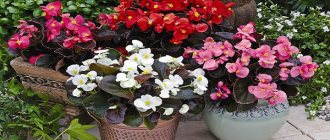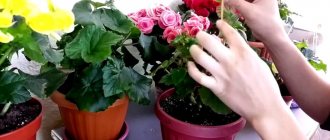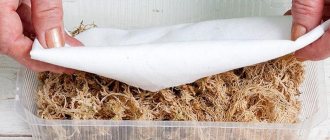Deciduous Decorative indoor plant with drooping stems. Very capricious. Not grown outdoors. Unusual colors: various contrasting patterns, spots, silver and pearlescent tints. TypeVarietiesFlowersErectDark RedLarge dark red, like a rose.Double yellowLarge yellow double.Pati DressResembling the original huge carnations on a small bush.Camellia Camellia.Camellia FloraPion-shaped, waxy, soft pink color with a snow-white border.Crispa White-redResembling a large carnation, white with burgundy or scarlet border. Pikoti lace eprikotmal, corrugated, apricot color, very large. Smambapastel -colored different shades, resemble cloves. Amploster shains medium, half -double or terry, two -color, similar to cauliflips. Specific tires. Skadpionovic .
Planting a begonia tuber in a pot
When purchasing tubers, follow the following recommendations:
- The best time for this is the end of January - beginning of March.
- Size - at least 3 cm, color - rich brown, without stains or damage.
- The presence of buds, but not grown.
Planted at the very beginning of spring:
- The container for planting is of medium size.
- A drainage system made of expanded clay and small stones for 1/3 of the pot is required.
- The soil is peat. When the buds grow to 5 cm, they are transplanted into begonia soil or substrate: sand, leaf soil, peat soil and humus (1: 1: 1: 1).
- The rounded side of the tuber is immersed in the soil, and the concave side is placed upward without deepening so that the sprouts can breathe.
- When rooting, add soil and cut off excess shoots. If the planting material does not exceed 5 cm, no more than 2-3 are enough.
By purchasing an adult plant, it is adapted to home conditions.
For a week or two, the flower is placed in the shade, without watering or fertilizing. They look for the presence of insects.
Caring for tuberous begonia at home
Although the flower is not capricious, it needs the creation of favorable conditions. In November, if they want to prolong the flowering of begonia, they continue to feed it and highlight it, follow the rules of watering and humidity, deceiving the plant so that it does not go to rest. But for his further life activity, it is imperative to give him a rest for at least 3 months.
| Factor | Spring | Summer | Autumn winter | ||
| Bloom | Peace | ||||
| Location | North window. | Western, eastern. | |||
| Lighting | Bright, but without direct sun. | They provide additional illumination. | Shade. | ||
| Temperature | +18 °C…+23 °C. | +15 °C…+18 °C, not lower when kept in a room. | Not lower than +12 °C and not higher than +18 °C. They cut it off. | ||
| Humidity | High is better. Do not spray. Place on a tray with a damp component: expanded clay, moss, sand. | Place a damp cloth on the battery next to the flower. | Provides dry air. | ||
| Watering | Abundant. | When the top layer of soil dries out. | Reduced (once a month). | ||
| Feeding 1 time. Flowering - complex fertilizers for flowering. Leaf - for ficus (1.5 caps per liter of water). | In 14 days. | In 7 days. | In 14 days. | Per month. | Not used. |
What and how often to feed for flowering
An indoor flower should bring aesthetic pleasure. The question of how to fertilize begonia for flowering becomes relevant. Ready-made products can be bought in the store; there are specially developed fertilizers for these plants (“Begonia” or “Good Power”).
What begonia looks like - types and varieties of flowers
The first element required for feeding is potassium. You can use a weak solution of saltpeter.
Additional Information! The flowering period of the plant is about six months - from May to December. Then the plant goes dormant. At this time, the flower loses its leaves and dries out.
In summer, feeding begonias should not stop. Complex fertilizers are used for house flowers. A popular combination product is Kemira Lux, which is used for both growth and lush flowering.
Frequency of fertilizer use:
- The first feeding is done during budding.
- Then every 2 weeks until rest.
Feeding can be done more often, but you need to make a weaker solution. When the plant stops blooming, the last replenishment with useful substances is done.
Important! Feeding tuberous begonias should not contain chlorine.
Blooming begonia
Planting begonias in open ground and further care
Planting is carried out when the threat of frost has passed, the best time is early June. Choose a place that is bright, but protected from direct sun and wind. Seedlings are gradually tamed to the open air.
Humus mixed with ash is poured into the bottom of the planting holes. The same composition is used to mulch the planted seedlings.
Outdoor care includes a number of features:
- Fertilize with humus, ash, potassium-phosphorus fertilizers from mid-spring to mid-autumn, once every 14 days.
- Pinch stems 7-8 cm high to stimulate the growth of lateral shoots.
- Water abundantly in hot summers, in rainy ones - as the soil dries 1 cm.
What is needed for abundant flowering?
Phosphorus promotes the formation of flower buds and abundant and long-lasting flowering. It is after a period of active growth, during the period of bud formation, that it is necessary to carry out potassium-phosphorus fertilizing in a complex. At this time, the dose of potassium salts should not exceed 1.5 grams per 1 liter of water.
Note! Phosphate rock is an ideal way to replenish phosphorus needs; it should be added to the soil of begonias at the rate of 70 grams per 1 square meter of soil.
Features and differences between wintering home and garden begonias
November is the beginning of the rest period, but this is an approximate period. It all depends on where the plant spent the summer. What is the goal, to extend flowering or reduce it. But in any case, the flower needs to rest for at least 3 months.
Indoor
When storing domestic plants in winter, they are not removed from the pot, but cut off, leaving a shoot of 1 cm. They are kept under the conditions described in the seasonal table.
Garden
At the end of October, garden specimens are dug up, the roots are shortened, treated with a fungicide (Fitosporin), dried, and placed in a container with peat. Place in a dark, dry room until spring. They can also be stored on the refrigerator door, wrapped in sphagnum moss or in a cotton bag.
In the spring, they are planted in a pot, and after germination, they are planted in open ground.
Begonia propagation
Tuberous begonia is propagated in 3 ways: by seed, cuttings and dividing the tuber.
Tuber
An effective method, but only possible if at least three buds remain on the parts.
Step by step:
- The tuber is cut with a disinfected sharp knife.
- Treat the cut with charcoal.
- Plant according to the planting pattern.
Cutting
With this method, in mid-spring, the following activities are carried out:
- Cuttings of about 10 cm are separated from the mother bush.
- Take a container with wet peat and plant sprouts in it.
- When they take root, they are planted. When replanting, pinch to encourage side shoots to grow.
Seeds
The method is long and labor-intensive. When placing a house, it is difficult to obtain seed material:
- flowers are artificially pollinated using a brush;
- When the fruits appear, it is not easy to collect the seeds, since they are very small.
Seed planting process:
- Seeds mixed with sand are scattered into a container with soil for begonias. Moisten with a spray bottle.
- Cover with a transparent lid (glass, film).
- After the emergence of strong shoots, they dive.
How to prune begonias
If you do not prune and pinch when caring for begonia in a pot, it will quickly lose its attractive appearance, stretch out, its stem will become bare, and the leaves and flowers will become small. To get a lush and beautiful crown, you need to start forming begonias as early as possible. This is done in the spring as follows:
- After their length is approximately ten centimeters, their top is also trimmed. When they are covered with new shoots, the formation of the bush is stopped;
- Subsequently, it is necessary to prune or remove overgrown or unnecessary branches.
In addition to a beautiful crown, pinching and pruning improve the flowering of begonias, ensure the correct proportions between the roots and the crown, and also rejuvenate the adult plant. Begonia pruning should be done using a sharp and clean knife to avoid infection. The sections are treated with crushed charcoal to prevent rotting.
Azalea care instructions can be found here.
How to care for alocasia is written here: https://cvetolubam.ru/alokazia/
This article will help you avoid mistakes when caring for indoor maple and its propagation.
Description of the plant
From late spring to mild autumn, our balconies, flower beds and front gardens are decorated with charming Begonia bushes with delicate buds and bright carved leaves.
Indoor Begonia
can delight owners with its beautiful appearance all year round. Usually a wide variety of species are planted in pots.
This is one of the most popular indoor plants
.
Caring for Begonia at home
requires a certain amount of time and attention.
Begonia
began to be used about 200 years ago for decorative purposes and continue to do so to this day.
This flower perfectly decorates our window sills, gardens, squares and parks.
The most common is considered to be tuberous Begonia.
. It is distinguished by its gorgeous large and beautiful flowers.
This is an indoor plant that blooms not only in summer, but also in winter.
.
Begonia
- a herbaceous plant, about three centimeters high, with very beautiful dense foliage of all shades of green, as well as varying in size.
The leaf is particularly asymmetrical: one side is always smaller than the other.
Flowering plant species have stunning, bright and large flowers
a variety of shades of warm tones. They resemble roses in shape and can be regular or double.
Today, thanks to various crossings, many species of this wonderful flower are known.
Popular varieties of evergreen begonia
Begonia everblooming is one of the favorite plants of breeders. Many varieties adapted to temperate climate conditions have been developed; they are cultivated in home plantings. Several varieties are the most popular.
Begonia "Lotto" is a tall, compact bush. The leaves are velvety, bright emerald. Large flowers can be painted in different colors.
Begonia "Senator" is a medium-sized bush with bronze leaves. Medium-sized flowers can have different colors.
Begonia "Ambassador" is a compact, medium-sized bush. Green leaves with bright red edges. The flowers are monochrome (white, red or pink) or bicolor.
Begonia "Queen" - low-growing bushes with bright green leaves and double flowers of carmine, pink or snow-white color.
Begonia "Cocktail" is a low-growing, lush-flowering bush. Leaves are brownish-red. The flowers are painted in scarlet, white, pink tones.
In today's article we will talk about begonia, more precisely about the features of caring for this flower. Thanks to its unpretentiousness, begonia occupies a leading position among flowers that are easy to grow at home; almost every amateur gardener has at least one representative from the begonia family.
What to look for when buying a plant
When purchasing, always be very careful when choosing a plant.
. In order for it to please you for a long time, it is important to choose a healthy flower.
Pay attention to the leaves, which should be firm and free of any spots. Leaves should be checked for insects or cobwebs. Experienced flower growers advise buying specimens with half-opened buds, because when the tropical guest gets used to the new home conditions, she will begin to delight you with lush flowering, and a plant with flowers in a new environment may shed its inflorescences.
If you prefer to grow Begonia
from tubers, they should be selected small and elastic. If they have brown spots, you should refuse to purchase, as this is one of the signs of improper care of the tuber.
If it so happens that you purchased a plant with pests, then try to immediately neutralize them and revive the plant. To do this, place it in the shade and treat it with preparations specially designed for this. Just remember to separate the flower from other plants so that they cannot become infected. Do not disturb the purchased flower for about a week, then surround it with complete care and proper care, from which your tropical guest will certainly perk up.
Fertilizers and nutrition for growth
How to feed phlox in June before flowering
Spring is the period of awakening of begonias, then they are transplanted into pots into a new substrate. Shoots begin to actively grow. The first feeding is relevant precisely at this time. Ammonium nitrate should be chosen as a fertilizer. Nitrogen and potassium agents stimulate the growth of shoots and the growth of green mass.
Note! Do not overuse ammonium nitrate. Excessive amounts of nitrogen prevent flowering and even the formation of buds.
Flower care at home
Soil and pot
When buying a pot for Begonia
, it should be taken into account that it should be several centimeters larger than the diameter of the earthen ball, since in pots that are too large, the roots of the plant may suffer from excess moisture content. And the plant itself will very slowly form future buds.
The soil for the plant must be special. For this purpose, it is better to purchase it in flower shops. But, you can also cook it yourself.
To prepare the required soil, you need to mix two parts of leaf soil with one part of humus, sand and peat.
Landing
Carrying out the process of planting a plant in a pot
, be sure to ensure that excess water is drained from the roots. To do this, place a good layer of drainage on the bottom of the pot, and be sure to pour a layer of coal on top, which will act as a disinfectant material.
After this, place the seedling in the center of the pot along with a lump of earth, and fill the resulting free space with substrate.
Next, water the flower and place it in a well-lit, permanent place of residence.
Lighting
This plant loves to be under bright light. It is the flowering specimens of the plant that usually need light the most. But from the excessive rays of the sun in the very heat of Begonia
It should still be shaded so that it does not suffer from burns.
Begonias
Decorative leaf varieties usually need diffused lighting. It is recommended to place the plant on the western or eastern side of the windowsill.
This plant loves warmth very much. The air temperature in the room should be maintained at about 22 degrees in warm weather , and about 18 in winter.
Watering
Begonia
, which grows indoors, needs to be watered quite often, once a day. But before each watering of the plant, you should carefully inspect the tray and the soil itself. In no case should water be allowed to stagnate in a pot or tray, otherwise the root system of the plant will begin to rot due to excessive waterlogging of the soil, and the flower, despite the best care for it, may die one way or another.
In winter, watering is reduced to once, maximum twice every seven days. Water the plant only when the top layer of Begonia
dry to 15 mm.
Try to water any house plants only with settled water at room temperature, and Begonia
, including.
Indoor air humidity
Begonia prefers high humidity.
air in the apartment. In nature, this flower grows in the tropics, where air humidity is 70%, and therefore, in our conditions, it is necessary to create the maximum humidity for the plant. You can create such conditions indoors by spraying from a spray bottle.
As a rule, it is not the plant itself that is moistened, but the air around it. Begonia
You need to spray very carefully, through a very fine sprayer, otherwise the drops will leave very unsightly spots on the leaves.
It is best to place these plants on small pallets with wet expanded clay. If you have a humidifier, it is ideal for this purpose.
Plant nutrition
Since the land is depleted over time, for good care of Begonia
It is necessary to use a vitamin supplement at home, which is recommended to be added once every six months during flowering.
Nitrogen fertilizer is more suitable for deciduous plant varieties. This additive improves the growth of leaves, and the flowering process slows down a little.
By following these simple rules, you can perfectly maintain the plant at home. Only with proper care will Begonia be able to delight with abundance
leaves and flowers.
Transfer
* Do not try to replant a plant you have just purchased and brought into your home. The plant will withstand the stress of changing its place of residence.
and will be sick for a very long time, postponing flowering to a later date, and the flowering period itself will noticeably decrease.
* You need to replant the plant only when you notice that there is not enough space for the roots to grow, and they begin to peek out in the drainage holes.
* When replanting, choose a pot two centimeters larger than the previous one.
* First of all, a layer of small pebbles should be placed on the bottom, then covered with a two-centimeter layer of the desired soil.
* Now you should crush the old pot on all sides and carefully remove the bush from it, being careful not to harm the roots. If necessary, the root ball should be untangled with a wooden stick, carefully straightening it.
* When you have moved the plant to a new pot, you can now cover its roots with new soil, compacting it a little.
* Now you need to water the plant with soft water.
* After transplantation, the plant will be under stress for some time. There is no need to put it in another place or move it at all. Give him time to get used to the new conditions. It usually takes about one month for a transplanted plant to adapt.
Errors and their consequences
If, when feeding plants, you do not adhere to the specified standards for certain products, then such negligence can lead to a number of consequences:
- If the plant is overfed, it may die.
- Oversaturation of a plant with organic or mineral fertilizers can lead to death; it is necessary to alternate fertilizers.
- If the plant has just been planted or transplanted, it cannot be fed for a month; an immature seedling can slow down the development of the root system.
- If a plant is sick, its feeding should be done carefully and start with small doses, since when the plant is sick, the roots of the plant are weakened and it can perceive nutrients as a destructive component.
- Feeding during flowering or dormancy can destroy the plant.
Descriptions, types and features of begonia care can be found in separate articles on our website. Read about:
- how it reproduces and what ways there are to propagate rooting begonia;
- why the plant’s buds fall off and the leaves turn yellow and dry;
- what are the rules for caring for the plant in winter;
- how to properly water and prune;
- when is a flower transplant needed and what pot is suitable for this.
Reproduction of Begonia in different ways
Once the plant has grown a bit, it's time to talk about propagation. Typically this process is carried out in several different ways:
Leaf propagation
With this method, you need to select a healthy and strong leaf and cut it along the veins so that each specimen has two veins.
Next, lay them on top of the wet sand and cover with film. The sand should be sprayed from time to time to prevent it from drying out.
As soon as you notice the appearance of the first sprouts, begin to gradually accustom them to room air. To do this, you need to open them from the film for 15 minutes and then close them again. Try to increase the time interval each time.
Propagation by stem cuttings
This type of propagation is suitable for Begonias
that have a stem. It is necessary to cut a good cutting, which has two or three leaves. The leaves located at the bottom should be removed immediately, and the upper large leaves should be cut in half. Treat the resulting cuts thoroughly with charcoal.
Prepare a pot of soil for Begonias
and with the same amount of sand, insert the cutting into it, deepening it to the very leaves. On top you need to cover it with a plastic bottle, cut in half.
After about one month, new leaves will appear on the plant. Begonia will bloom after this
in about two months.
Reproduction by dividing the bush
This plant can be propagated
using rhizomes. In this case, you need to remove the plant from the pot and soak the roots in water for a while. After this, the rhizome should be carefully divided into parts so that each has a sprout or bud.
All excess unnecessary leaves and inflorescences should be removed. Be sure to treat all cuts with charcoal.
Now the plant can be planted in different pots and watered thoroughly.
Propagation by seeds
This method is not considered the most popular due to the fact that not all seeds usually germinate or may be viable. However, this method is also used.
To do this, prepare a substrate in advance, into which the seeds are then sown. They are not covered with earth from above, but simply sprayed with water from a spray bottle and covered with either glass or film, as is convenient for you. From time to time, the film is lifted to allow the soil to ventilate, thereby preventing the soil from becoming waterlogged.
The grown sprouts should be thinned out, wait until they are well strengthened, and you can transplant them into separate pots.
Reproduction of tuberous Begonia
When autumn comes, the leaves of the flower are cut off, the tubers are removed from the soil, well cleaned from the soil, and then thoroughly dried.
In the spring, in May, the tubers need to be cut into a small number of parts. Make sure that roots and sprouts remain on each part of the tuber.
The side that was cut must be dipped in charcoal and placed in peat. There is no need to deepen them, since a small part of the tubers should be on the surface of the soil. Make sure that the peat does not have the opportunity to dry out. The temperature in the room below should not drop below 12 degrees.
You must be patient as the germination process this way is very slow.
General rules for applying fertilizers
Do I need to pinch begonia and how to do it?
Begonia should be fed following certain rules.
- The frequency of fertilization is once every 1.5-2 weeks.
- It is better to apply fertilizer in the evening.
- 2-3 hours before fertilizing, you need to moisten the soil well with settled or filtered water.
- Perform only root feeding, being careful not to get it on the leaves and flowers. Otherwise they will turn yellow and dry out.
- It is important to remember the measure. An excess of any fertilizer can cause toxicosis and death of the plant.
Important! For good absorption of nutrients, the pot with tuberous begonia should be placed in a well-lit room and kept at a temperature from 13 ° C to 23 ° C.
Watering the flower can be done with diluted fertilizer
Diseases and pests
Begonia quite often suffers from powdery mildew.
. This is a fungal disease that is formed due to excess moisture. In order to prevent the development of this disease in time, you need to carefully examine the lower leaves and the core of the bush. It is these parts of the plant that are most vulnerable to disease.
If a problem is detected, immediately stop watering the plant and remove all affected areas. This will stop the fungus from growing throughout the flower.
The main pest for Begonia
are red spider mites and aphids. In order to get rid of them, you need to spray the leaves with special preparations, and then put a bag on the plant so that it cannot allow air to pass through. This is necessary to enhance the effect of the plant.
If you do everything correctly, no pests will be harmful to your plant.
Conclusion:
Begonia flower is a very grateful plant
. If you care for it correctly and with all the love, then the beauty, health and gorgeous flowering of the plant will appear in full force. They will bring brightness into your life and give you unforgettable moments of happiness.











